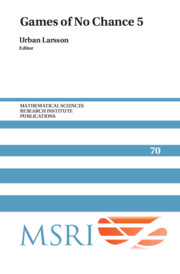Book contents
- Frontmatter
- Contents
- About this book
- Temperatures of games and coupons
- Wythoff visions
- Scoring games: the state of play
- Restricted developments in partizan misère game theory
- Unsolved problems in combinatorial games
- Misère games and misere quotients
- An historical tour of binary and tours
- A note on polynomial profiles of placement games
- A PSPACE-complete graph nim
- A nontrivial surjective map onto the short Conway group
- Games and complexes I: Transformation via ideals
- Games and complexes II: Weight games and Kruskal–Katona type bounds
- Chromatic nim finds a game for your solution
- Take-away games on Beatty's theorem and the notion of k-invariance
- Geometric analysis of a generalized Wythoff game
- Searching for periodicity in Officers
- Good pass moves in no-draw HyperHex: two proverbs
- Conjoined games: GO-CUT and SNO-GO
- Impartial games whose rulesets produce given continued fractions
- Endgames in bidding chess
- Phutball draws
- Scoring play combinatorial games
- Generalized misère play
- Retrospective Author Index
Chromatic nim finds a game for your solution
Published online by Cambridge University Press: 29 May 2025
- Frontmatter
- Contents
- About this book
- Temperatures of games and coupons
- Wythoff visions
- Scoring games: the state of play
- Restricted developments in partizan misère game theory
- Unsolved problems in combinatorial games
- Misère games and misere quotients
- An historical tour of binary and tours
- A note on polynomial profiles of placement games
- A PSPACE-complete graph nim
- A nontrivial surjective map onto the short Conway group
- Games and complexes I: Transformation via ideals
- Games and complexes II: Weight games and Kruskal–Katona type bounds
- Chromatic nim finds a game for your solution
- Take-away games on Beatty's theorem and the notion of k-invariance
- Geometric analysis of a generalized Wythoff game
- Searching for periodicity in Officers
- Good pass moves in no-draw HyperHex: two proverbs
- Conjoined games: GO-CUT and SNO-GO
- Impartial games whose rulesets produce given continued fractions
- Endgames in bidding chess
- Phutball draws
- Scoring play combinatorial games
- Generalized misère play
- Retrospective Author Index
Summary
We play a variation of nim on stacks of tokens. Take your favorite increasing sequence of positive integers and color the tokens according to the following rule. Each token on a level that corresponds to a number in the sequence is colored red; if the level does not correspond to a number in the sequence, color it green. Now play nim on an arbitrary number of stacks with the extra rule: if all top tokens are green, then you can make any move you like. On two stacks, we give explicit characterizations for winning the normal play version for some popular sequences, such as Beatty sequences and the evil numbers corresponding to the 0's in the famous Thue–Morse sequence. We also propose a more general solution which depends only on which of the colors “dominates” the sequence. Our construction resolves a problem posed by Fraenkel at the BIRS 2011 workshop in combinatorial games.
1. Introduction
At the workshop in combinatorial games in BIRS 2011, Aviezri Fraenkel posed the following intriguing problem: find nice (short/simple) rules for a 2-player combinatorial game for which the P-positions are obtained from a pair of complementary
Beatty sequences [Be]. We begin by solving this problem, by defining a class of heap games, dubbed bichromatic nim, or just chromatic nim, and then later in Section 4, we explain some background to the problem. In Section 3, we solve a similar game on arithmetic progressions. In Section 5, we discuss the general environment for chromatic nim on two heaps. At last, in Section 6, we study the famous evil numbers, also known as the indexes of the 0's in the Thue–Morse sequence.
2. Bichromatic nim finds a game for your complementary Beatty solution
Let S denote a subset of the positive integers. We let the i-th token in a stack be red if i ϵ S, and otherwise the i-th token is green. We play a take-away game on k ≥ 0 copies of such stacks of various finite sizes. Classical nim rules are always allowed; any number of tokens can be removed from precisely one of the stacks.
Information
- Type
- Chapter
- Information
- Games of No Chance 5 , pp. 313 - 332Publisher: Cambridge University PressPrint publication year: 2019
